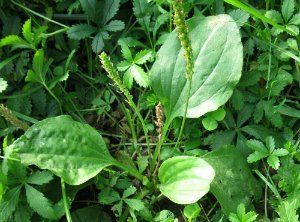Description: Plantain, scientifically known as Plantago major, is a perennial herbaceous plant belonging to the Plantaginaceae family. Commonly found in lawns, meadows, and disturbed areas, this versatile plant has earned recognition for its characteristic rosette of broad leaves and tall flower spikes. Plantain is native to Europe but has become naturalized in various regions worldwide.
Habitat and Distribution: Plantain is well-adapted to a variety of habitats and is often found in lawns, gardens, roadsides, and fields. It thrives in compacted soils and is commonly considered a weed, although it has some medicinal uses. Plantain has a widespread distribution due to its ability to tolerate diverse soil conditions.
Physical Features:
- Leaves: The leaves of Plantain form a basal rosette and are oval to lance-shaped, with prominent parallel veins. They have a distinct ribbed texture and are typically hairless.
- Flowers: The flower spikes of Plantain emerge from the center of the rosette and are adorned with small, densely packed flowers. The flowers are inconspicuous and lack colorful petals.
Ecological Significance:
Plantain plays ecological roles such as:
- Soil Stabilization: The fibrous roots of Plantain help stabilize soils, making it useful in preventing erosion in disturbed areas.
- Pollinator Support: The inconspicuous flowers attract various pollinators, contributing to local biodiversity.
Cultural Uses:
- Edible Greens: Young leaves of Plantain are edible and can be consumed raw in salads or cooked as greens. They are a good source of vitamins and minerals.
- Medicinal Uses: Plantain has a history of traditional medicinal use. The leaves are often used topically for their potential anti-inflammatory and wound-healing properties.
Control and Management:
Cultural Practices:
- Mowing: Regular mowing can help control the height and spread of Plantain in lawns. However, it may not eliminate the plant entirely.
- Improving Soil Conditions: Addressing soil compaction issues and improving soil fertility can discourage the growth of Plantain.
Mechanical Control:
- Hand Pulling: Hand pulling is effective for small infestations. Ensure the entire root is removed to prevent regrowth.
- Cutting Flower Spikes: Removing flower spikes before seed production can help limit the spread of Plantain.
- Chemical Control: Herbicides: Selective herbicides labeled for broadleaf weed control can be used to target Plantain. Carefully follow application instructions to avoid harm to desirable plants.
Preventing Spread:
- Early Detection: Regularly inspecting lawns and gardens for signs of Plantain is crucial for early detection. Prompt removal or control measures can prevent its spread.
- Minimizing Soil Disturbance: Minimizing soil disturbance during lawn maintenance or gardening activities can help reduce the germination of Plantain seeds.
- Promoting Desired Vegetation: Encouraging the growth of desirable plants in lawns and landscapes can help outcompete Plantain and limit its establishment.
In conclusion, while Plantain has some cultural uses and ecological benefits, its weed status in lawns and gardens may require management efforts. Integrated control methods, including cultural practices, mechanical removal, and, if necessary, targeted herbicide application, can help manage Plantain populations and strike a balance between its positive attributes and the need for control in certain environments.



